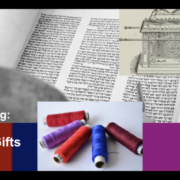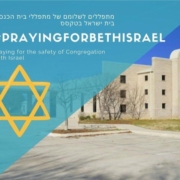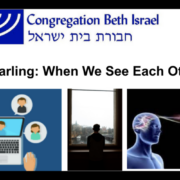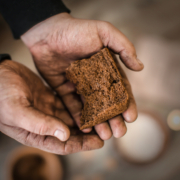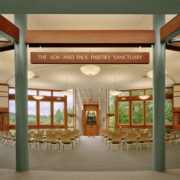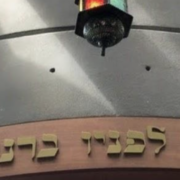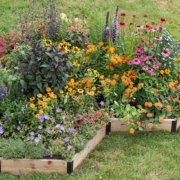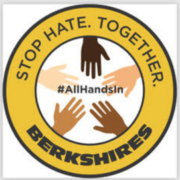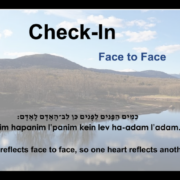This week’s Torah portion contains one of my favorite verses: “Let them make Me a sanctuary, that I might dwell among them.” The Hebrew could also mean “within them.” We build God a sanctuary so that God — holiness, love, justice — can dwell within us….
Dear Congregation Beth Israel community,
There is nothing quite like the gut-wrenching feeling of emerging from the peace of Shabbat — a day when some of us avoid the news or social media — into the news of violence in a synagogue, again. Thank God, after eleven tense and terrible hours the hostages were freed. But in a time when we may already be feeling vulnerable, because of pandemic and climate crisis, this attack may heighten our sense of fragility.
Some of us may be feeling especially vulnerable because the name of the synagogue in Colleyville, Texas matches our own. Congregation Beth Israel means house of Israel: house of our people, our family, our community that takes its name from Jacob who became Yisrael when he wrestled with an angel all night until dawn.
Every Jewish house of worship, and every Jewish community, is a house of Israel. We are the people Israel: all of us. And our tradition teaches “kol Yisrael arevim zeh bazeh:” all of Israel is responsible for one another. Or, phrased differently: we are all interconnected in a web of mutual responsibility and care.
Dr. Martin Luther King, Jr., to whom this weekend is dedicated, taught something similar. In his 1963 Letter from a Birmingham Jail, he wrote: “In a real sense all life is interrelated. All [of us] are caught in an inescapable network of mutuality, tied in a single garment of destiny. Whatever affects one directly, affects all indirectly.” (We will hear those words in haftarah trope at this afternoon’s Tu BiShvat Zoom seder.) What happened yesterday underscores this teaching. What happened in a suburb of Fort Worth, Texas, impacts all of us everywhere.
After the Tree of Life massacre in Pittsburgh, CBI received a grant to upgrade our security. The CBI Board and I will talk about any further work we may need to do to keep our community safe when the pandemic permits us to gather once again in our beautiful building.
And I’ve learned from colleagues that CBI Colleyville let the shooter in because they presumed he was homeless and needed help. In so doing, they were living out some of our highest Jewish values. I don’t know how best to keep our community safe while also keeping our spiritual doors open to those in need, but I know that together we will work to find that balance.
Some of us may recall that after the Pittsburgh shooting, CBI also received a driveway full of love: posters and artworks and signs assuring us that we are welcome here, that the greater North Adams community stands with us, that we are loved and our neighbors want us to be safe. Even as we physically “harden” our building against attack, our spiritual tradition calls us to keep our hearts soft: to connect with each other, to cultivate emotional openness, to remember that we are all interconnected.
I am here if any of you need to talk. I am holding each of you in my heart. May the spiritual sap rising this Tu BiShvat fuel the growth of hope, and compassion, and safety for all.
Blessings —
Rabbi Rachel
Ordinarily on Shabbat Shuvah I would talk about teshuvah, return — turning our lives around, returning to our Source and to our highest selves. This is, after all, the work of the season. But I think that in this second pandemic year, there’s no shortage of time for introspection — a lot of us have been too alone, or turning too inward. So instead I want to talk today about what connects us with each other, and what it might mean to return to each other and to community.
Over the summer I had the opportunity to co-teach a pioneering rabbinic school class on doing Jewish digitally, with my friend and frequent collaborator Rabbi David Markus. We covered a lot of ground, ranging from the nature of prayer and ritual, to wise use of visuality, to creating spiritual and tangible “runways” into the digital ritual experience. And in one of our sessions, we opened with some classical texts about what makes a minyan.
Rambam wrote in the 1170s that “[c]ommunal prayer always is heard [by God]. … Thus, one must join oneself with the community, and never pray alone whenever one is able to pray with the community.” (Mishneh Torah, Prayer 8:1.) This is part of Judaism’s fundamental communitarianism. Can one talk to God alone? Of course! But it’s not good to separate oneself from community. The community needs us to show up, because in coming together to make a minyan, we also come together to make community.
Alongside that, we studied a text from the Shulhan Arukh, written in 1563 by Joseph Karo:
All 10 must be in one place, and the prayer-leader with them…One standing behind the synagogue, and in-between them is a window – even if it is several stories high … – and [whose] face is visible to them from there, joins them to make 10. If a few of them are inside and a few are outside, and the prayer-leader is in the doorway, the prayer-leader connects them [into one minyan]. (O.C. 55:13-15)
The simplest way to make a minyan is ten people in one place, including the prayer-leader. That seems pretty clear. But then he goes on to say: if one person is outside the room, but can be seen from inside, that person can be included. And if some are in one space and some are in another, they can all be included. So long as the prayer leader can see them, that being-seen connects them into one community, even if they can’t all see each other.
As soon as I read that, I thought: welcome to Zoom / hybrid / digital services, y’all.
Joseph Karo could not have imagined Zoom services or the hybrid services we’ve been holding all summer, with some participating onsite and others participating online. But he was already wrestling with this question that’s live for us now: how do we create sacred community when we’re not all in the same physical place?
For Karo, community arises when we can see each other. If I lead a service and it’s broadcast on television, the people watching it might or might not have a meaningful experience — but they can’t be counted in a minyan together, because there’s no two-way connectivity. I can’t see them, and they can’t see each other. I think he’s right, which is why I’ve made a practice of including periodic “face to face” slides where we stop the screenshare and meet each others’ eyes.
I think he’s on to something in a deeper spiritual sense, too. What makes us a community is not whether or not we can convene to pray in the same room at the same time… because if that were the case, then anyone who doesn’t show up to pray ceases to be part of the community! and if that were the case, then our community would have evaporated when the pandemic hit and we, along with so many others, started sheltering in place at home.
We become community when we see each other. I would go further: we become community not just when we glance at each others’ faces, but when we try to see each other fully. When we see what matters to each other. When we see what enlivens each other. When we see not only each others’ faces but each others’ hearts.
It turns out that when we see each other, something in us changes. Mirror neurons are brain cells that fire their electrical pulses both when we do a thing, and when we see someone else do that same thing. This was first observed in monkeys in an Italian lab some thirty years ago: electrodes in their brains showed neurons firing when they handled food, and when they saw someone else handle food — even when they merely heard the sounds of food being handled outside of their line of sight. Some researchers think that mirror neurons explain why we can have strong emotional reaction to characters on TV or in movies: because when we see them, we feel-with-them.
Being together on Zoom is not the same as being together onsite. We can’t sing in harmony on Zoom, or hug each other, or have that feeling of being together in a room. But when we see each other, our mirror neurons still work their magic.
For Joseph Karo, one of the roles of the shaliach tzibbur (the prayer leader) is to see all the souls in the room — and in seeing them, to constitute them into community. This is not a rabbinic job per se. Any adult Jew who learns the liturgy can lead the community in prayer. And any one of us who makes an effort to really see the other souls in the room can create some of the cohesion that makes us a community.
As you’ve heard me say several times this year, our theme for this year’s Days of Awe is gevurah, which means strength and power. It means boundaries. It evokes resilience and courage, too. It takes gevurah to really see each other, to be mindful of where I end and where you begin, to honor our differences without diminishing what connects us. It takes gevurah to connect with each other in these pandemic times when we may feel overwhelmed or despairing, or we may find the technologies of Zoom opaque. It takes gevurah to create community.
An invitation: to see each other deeply.
To awaken our mirror neurons as we see each other.
To create community together by seeing each other where we are, as we are, in all that we are.
Cross-posted to Velveteen Rabbi.
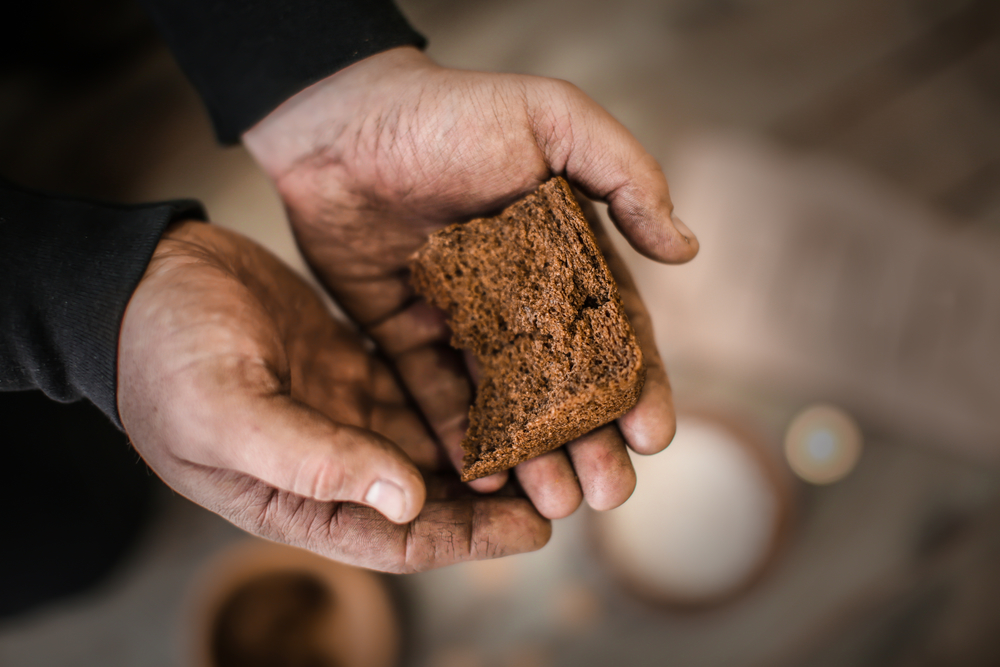
Dear Congregation Beth Israel members and friends,
During the Days of Awe, many synagogues hold food drives for dried and canned foods. We have done this for many years at CBI, in order that the Yom Kippur fast from food and drink be meaningful.
As it turns out, food pantries typically prefer monetary donations to canned food donations. Money doesn’t need to be sorted (as our bags of dried and canned foods do); money does not expire; money enables them to choose what they want and need to feed patrons, rather than relying on what are all-too-often unwanted old cans; and the food pantry can stretch our dollars to purchase more in bulk than what they would be able to provide via our donated cans and boxes alone.
Although not all of us fast from food and drink on Yom Kippur, we can choose to donate to local food pantries during this sacred season. Feeding the hungry is a mitzvah, and so is caring for our local community.
This year, please donate as you are able to help all who are hungry come and eat. You might donate to the Berkshire Food Project, the Friendship Food Pantry, or the Williamstown Food Pantry… or support Mazon: a Jewish response to hunger.
Jewish tradition holds that even one who receives tzedakah is obligated also to give it. What matters isn’t how much we can give, but that we give. Many of us have the luxury of knowing that our stomachs will grumble with hunger on our holy day of fasting but not on the days before and after. Let’s do what we can to ensure that no one in our community goes hungry.
G’mar chatimah tovah — may we be inscribed and sealed for goodness.
Blessings to all,
Rabbi Rachel

Dear Congregation Beth Israel members and friends,
It scarcely seems possible, but the Days of Awe are right around the corner. On August 28 we’ll officially enter into the high holiday season with Selichot, our annual service of forgiveness prayers to stir the soul, high holiday melodies to open the heart, and an opportunity to write down some of the places where we’ve missed the mark in the last year — a first step toward letting them go and committing to change. That service will be offered both onsite and online; if you’re joining us onsite, please wear a mask (we’ll be in the building, socially distanced, with doors and windows open.)
Preparing for this year’s Days of Awe has been unlike any other year — even last year. Last year, it was clear that the correct course of action was to shelter-in-place and make our homes holy. This year has been a rollercoaster of ups and downs, from the cresting of hope when vaccinations became available to the emotional plummet when the Delta variant reached our community. The CBI Board and I spent all summer planning for three possibilities simultaneously; consulting with the URJ and with other congregations both locally and regionally; discussing risks with medical professionals; and always circling back to to our sacred path of mitzvot and to the Jewish values that guide us. I believe that our current plan will allow us both to protect the vulnerable and to give those who wish to be onsite an opportunity to do so… and I’m mindful that if the situation worsens in the coming weeks, we may need to pivot again.
Last year when the Days of Awe were over, you told us that our Zoom services helped you feel connected; that our time together on Zoom felt real; that you appreciated the interweaving of ancient words and modern technology; that you were moved by the opportunity to see each other on Zoom; that you felt like you were part of a community even though we weren’t all in the same room. I hope and pray that this year will be equally uplifting. I’m excited to share some new things with you — including new music to carry us through the season, hopefully some piano accompaniment on Yom Kippur morning thanks to one of our new members, and a brand-new Jonah play for Yom Kippur afternoon. And I’m also looking forward to continuing our longstanding traditions, the words and melodies and modes of prayer that have sustained us for generations.
Hopefully if you wish to attend a service onsite during the holidays, you’ve already filled out our online registration form and indicated which service you would most want to attend onsite. That registration form will close at the end of the day on August 25 so that we can turn to figuring out how to (hopefully) enable each member who wishes to be onsite to attend one of their top-ranked services onsite. Of course, all of our offerings will be open to you online throughout the season.
We’re also preparing now for the coming Hebrew school year, which is slated to be onsite and masked just like local schools. We’re planning a series of monthly Family Programs, from an apple orchard outing in September to midwinter Saturday afternoon pajama parties with storytime and havdalah. If there is interest, we can reconvene our monthly Shabbat Zoom dinners to stay connected over the winter. And of course we will continue to offer Shabbat services and festival observances all year long, as always.
Your donations make all of this possible. We can’t operate on revenue from dues alone; that revenue does not fully support the work of our synagogue. Your contributions make up the difference and allow us to do all of the things we do, including offering memberships to those who cannot afford to pay full dues. In Torah we read that each Israelite gave a half-shekel to support the spiritual life of the community. We also read that many Israelites gave a t’rumah offering, a freewill offering from the heart over and above the half-shekel that everyone was obligated to provide. Regardless of amount, supporting spiritual community is a Jewish obligation. Giving is a religious act, and our sages teach that when we give tzedakah, we prime the pump of blessing to flow into the world.
Please support CBI.
Thank you.
Thank you for being a part of our synagogue community. Thank you for gathering with us, learning with us, and praying with us. (Please encourage farflung friends and family to join our email list so that they can join us for Zoom Days of Awe!) And thank you for your support of the synagogue of northern Berkshire county. Please give as you are able. We need your support especially in these difficult pandemic times. The only donation that’s too small is none at all.
Looking forward to being with you soon during the Days of Awe. May the rest of this month of Elul open our hearts and souls to transformation, and may the spiritual updraft of the holidays lift us ever higher.
Blessings to all —
Rabbi Rachel

Dear Congregation Beth Israel Members and Friends,
The CBI Board and Rabbi just met to discuss current COVID rates in our constituent towns and across the county, and to re-evaluate our high holiday plan in light of current realities. As of now, our plan for the Days of Awe is as follows:
- We will be holding hybrid / multi-access services, limiting capacity to ~45 so that pods can be 6 feet apart. Masks are required, with no exceptions. As a reminder, our erev Rosh Hashanah offering will be a Rosh Hashanah seder, held online only; here’s a list of items to have on hand for that digital community experience.
- All onsite participants over the age of 12 must be vaccinated. Parents who want to bring unvaccinated children (under the age of 12) with them into the service may do so, as long as the children remain masked and socially distanced, and as long as they are pre-registered for a seat or can sit on a parent’s lap. We will not require proof of vaccination; we trust our members to be truthful. We will check people off the registration list at the door so that we can facilitate contract tracing in the event of a COVID diagnosis.
- Childrens’ services will be held outdoors at 10am on Rosh Hashanah morning 1 and on Yom Kippur morning, with masks and social distancing. Please register with the CBI Office if you are bringing child/ren to the childrens’ service so we know how many kids to expect. (If there is mist or light rain, bring an umbrella or rain jacket to childrens’ services! If the weather is truly inclement, we will not be able to hold childrens’ services — in that case we will post on the CBI Facebook that morning to let everyone know.)
- All are welcome to join us online in the synagogue Zoom room. We will offer a robust Zoom option so that those participating online can fully take part in our high holiday experience. This allows us to welcome those who are immunocompromised, those who are at greater medical risk, and those who are homebound to participate in our Days of Awe — as well as those who aren’t on the onsite list for any given service.
Our guiding Jewish values in this decision are pikuach nefesh (saving life) and kol Yisrael arevim zah bazeh (all of us are responsible for each other; we are responsible for our community together.) Our job, as Rabbi and Board, is to serve this community and to keep this community safe. This is our best sense of how to live up to those values.
Now that we have evaluated recent local COVID levels and reached this plan, we will work on figuring out who can come to each service onsite, based on your responses to our registration form (sent in July and in every weekly announcements email since.) If you have not yet responded, please do so by August 25. Registering and ranking your preferred services is the only way to get on the registration list for onsite services. We may not be able to give everyone their first choice. We will do our best. We are compiling registration lists now for each service, and we will be in touch to share those lists so you know which service(s), if any, you will be attending onsite.
Some have asked why we’re not renting a tent. When we explored that option early in the summer, we learned that in order to proceed with a tent, we would need to reserve and pay for one immediately. The expense would be large, and we would still be limited in space / configuration because of the layout of our available land. At that time, the Delta variant had not reached us. Based on these factors, and based on the results from our survey of the membership about what people wanted, we made the decision then to forego the tent.
This is our current plan, crafted with our deepest hopes for a sweet and meaningful holiday season. And, as we’ve learned in the past year, we need to be prepared to pivot if the situation shifts. Please continue to keep an eye out for communications from CBI. If the COVID situation worsens, we will move to offering all-digital services as we did last year.
Wishing you blessings as we approach the Days of Awe,
The CBI Board of Directors
(Chris Kelly, President; Natalie Matus, Vice-President; Michael Smith, Treasurer; Paulette Wein, Clerk; Joe Apkin, David Lane, Darlene Radin, and Ben Rudin)
and Rabbi Rachel Barenblat
There is nothing superfluous in the universe. Even flies, gnats, and mosquitoes are part of creation and, as such, serve a divinely-appointed purpose.
— Bereshit Rabbah

We’re Starting a Pollinator Garden!
CBI is starting a pollinator garden! (More on that below.) The first step is building a few raised beds, and we could use your help.
If you have extra lumber (2x4s of any length, untreated) sitting in your garage, we’d love to make good use of it. You can drop off donations at CBI. If you’d like to help with building or planting (or tending the garden once it’s built), please contact Caleb at caleb.wolfsonseeley at gmail dot com. Thanks!
What’s a Pollinator Garden?
A pollinator garden is a garden designed to support and maintain pollinators (butterflies, bees, etc) by supplying food in the form of pollen and nectar that will ensure that these important animals stay in the area to keep pollinating things. A pollinator garden benefits our ecosystem while also beautifying our grounds. Ours will begin with one bed of herbs, and one bed of flowers — some with Torah connections! — and some of the aromatics will become part of havdalah at CBI in years to come.
Why a Pollinator Garden?
This garden will enable us to care for the environment at CBI, as an expression of the Jewish value of bal tashchit, “do not destroy [the natural world]”; to provide sustenance for pollinators, such as butterflies and bees, with awareness that these are an essential part of our ecosystem; to create more natural habitat on our land, remembering God’s commandment l’avda u’l’shamrah, “to till and tend” the Garden of Eden; and to bring our community together on our beautiful grounds.
When a person commits any wrong toward a fellow human being, thus breaking faith with YHVH, and that person realizes their guilt, that person must confess the wrong that he has done. They shall make restitution in the principal amount and add one-fifth to it, giving it to the one whom they have wronged. (Numbers 5:6-7)
Early in this week’s Torah portion, Naso, comes this injunction. The first thing that jumped out at me this year is that when a person wrongs another person, they are “breaking faith with God.” What commitment did we make to God that we break when we wrong each other?
Last weekend we stood at Sinai and received Torah anew, and Torah is full of ethical instructions about how to act justly and with compassion. That’s the promise we made to God: we’ll keep the mitzvot. When we harm each other, we fail to live up to that promise.
So this week Torah teaches: when we realize we’ve wronged someone, there are two steps we need to take. First, we admit the wrong. Then we make restitution — and then some. If I wronged you fiscally, I need to repay the money and add an additional one-fifth. If I harmed you in some other way, I need to go the extra mile to repair the damage I’ve done.
This week I learned that all of the people of color on Williamstown’s Diversity, Inclusion, and Racial Equity committee are stepping down because they are so disheartened. This week I learned that all of the people of color on Williamstown’s Diversity, Inclusion, and Racial Equity committee are stepping down because they are so disheartened. [Edited to add: I misspoke. Jeff Johnson will remain, though as an ex officio member. But five people of color are stepping down.]
Some of them received threats to their lives. Others received public attacks on their character. The questions they bring to the table — How inclusive are we? How welcoming? How safe and supportive? — are for all of us to answer together, but a lot of us — me included — didn’t participate or offer active support.
And I thought: I know what it’s like to be Jewish in a time of rising antisemitism. As Jews, we get exhausted naming and fighting antisemitism, especially if it feels like no one else notices or cares. When others pick up some of that load, their allyship helps us in all kinds of ways. As this recent volume attests, allyship is holy work. I saw the news about resignations from the DIRE committee, and I realized: I’ve fallen down on the job of being an ally to people of color in my community.
I didn’t mean to cause harm. I just… wasn’t paying attention. I hadn’t really thought much about how serving on that committee could be traumatic for people of color, because they’re always teaching the town’s white community what we don’t know about racial injustice. And we don’t always want to hear it. Sometimes we might be actively resistant to hearing about experiences of racism in our town. And sometimes we’re passively resistant, and we just don’t pay attention.
That kind of tuning out is a luxury I have as a person with white skin. It’s like the way a lot of Christians don’t notice antisemitism because it’s not directed at them. But when we treat racial justice as something we can choose either to notice or to ignore, that itself inscribes some harm. My inaction and inattention are part of the problem. I need to make this right, and this week’s Torah portion reminds me that really repairing damage requires me to go the extra mile.
I’m still figuring out what that means for me in practical terms. Paying more attention to town government. Using my voice as a clergyperson to speak up for those who are marginalized or have experienced injustice, especially people of color. Writing more letters to the selectboard, maybe. Educating myself (an essential component of the work of allyship.) Uplifting the voices and the needs of people of color in my town. (If you have suggestions, I welcome them.)
Though the DIRE resignations are heavy on my mind and heart this week, this isn’t just a Williamstown problem. This is work we all need to do, in all of the communities where we live.
Later in this week’s Torah portion, God instructs Moses to tell Aaron to offer certain words to the people. This is the origin of the words I say to my child every Friday night as Shabbat begins, the words I say to every b-mitzvah kid who stands on our bimah:
May God bless you and keep you!
May God’s presence shine before you and be gracious to you!
May God’s presence always be before you, and bring you peace.
The path our tradition offers us toward blessing and radiance and grace and peace is following the mitzvot. And that includes acting ethically, and protecting the vulnerable, and repairing what’s broken. It includes recognizing and confessing our missteps, and making restitution and then some.
So here’s my blessing for us this morning:
May we be strengthened in the holy work of allyship.
When we fall short, may we do what we can to bring repair.
When we can do that, we’ll feel God’s presence before us and within us and around us and between us. And then every place will be a holy place.
And let us say: amen.
This is Rabbi Rachel’s d’varling from Shabbat morning services this week (cross-posted to Velveteen Rabbi.)
If you can’t see the embedded video, above, it’s here on YouTube. You can also read the text of the video below.
Dear CBI Community,
As we look toward hopefully offering hybrid services this summer, I’m here to share some of the challenges and opportunities involved in shifting from all-digital offerings to hybrid ones. Of course there’s the challenge of staying on top of changing CDC guidance! But aside from the medical, there are also practical, spiritual, and communal impacts to how we make that shift.
I’m part of two clergy groups that arose at the start of the pandemic. One consists of about 3000 Jewish clergy from across the denominations. The other is for clergy of all faith traditions, and has 7500 members. In both of these groups, we share questions, resources, and emerging best practices. What we’ve been doing at CBI draws on the cumulative wisdom of all of these folks.
When I lead prayer over Zoom, I screenshare slides that feature images and artwork and sometimes even video clips alongside the words of our prayers… and at strategic moments in the service, there’s a slide that reminds me to stop the screenshare so that we can all see each other’s faces, wave to each other, and remember that we’re connected in community together.

Some of us use the chat function in Zoom to connect with each other during services, chatting with each other via text, or sending a chat message to the whole room (for instance, if I ask people to share a blessing that they’re thankful for this week, or when I ask for names for healing.) Sometimes I call on people to lead a prayer from the place where they are.
One of the ways we’ve sought to sustain our community during the pandemic is through making our Zoom offerings as interactive as possible. Because of that interactivity, members and friends of CBI who live elsewhere or have moved away can join us not only in prayer but in seeing each others’ faces, texting each other messages, and being connected across distance.
As we approach the next phase of the pandemic and the return to some in-person prayer, one of the biggest questions is: how can we make services most meaningful and participatory both for the “Roomies” (physically present) and the “Zoomies” (participating remotely)? Is there a way to do so that truly serves both of these constituencies, and that “works” for both groups at once?
Once we’re back at the shul, it’s easy to share a service via Zoom / Facebook Live — but that’s a broadcast paradigm, not an interactive one. Those who are remote can’t participate as fully, and can’t share their faces or voices with each other or with those in the room. That’s how we used to stream high holidays. But it’s not interactive, unlike what we’ve done over this pandemic year.
Across the denominations, we’re all grappling with how the pandemic has changed how we do Jewish and how we constitute community. We’ve spent more than a year “making a minyan” from afar, spanning from North Adams to Florida to California. The tenth member of our minyan might be in another time zone! That changes our felt sense of what it means to be together.
It’s a paradigm shift for Jewish life everywhere. And we may not wholly understand its impacts until we can look back on this moment, five or ten or fifteen years from now. One thing that is clear is that this new way of constituting and connecting community opens doors for those who are disabled or homebound, and we need to figure out how to keep those doors open.
Some communities are now installing large screens in their sanctuaries, one to show the digital prayer materials (also shared over Zoom) and another to show the grid of all the faces participating on Zoom, so that those on Zoom can see who’s in the sanctuary and vice versa. Some schools operate that way now, and businesses too. Of course, that’s a major investment.
We don’t yet have answers on how best to do this. (As a recent essay from the Union for Reform Judaism points out, no one does — and they have wise thoughts on why we should be thinking in terms of “multi-access” offerings, not just “hybrid” ones.) But these are some of the questions that clergy across the denominations and across faith traditions are grappling with.
I know you’re probably eager to know what we’re going to do for the Days of Awe. I am too! The Board is exploring everything from tent rental, to screen(s) in the sanctuary, to whether it’s safe for people who are vaccinated and masked to sing together, to what’s best for our unvaccinated children and their families. Thanks to all who filled out our survey: your answers help us plan.
If you have thoughts about going forward, I welcome them. Please know that I always want to hear from you about what you want and need, or about whatever’s on your mind and heart.
For now, I wish you every blessing during this final week of the Omer, and I hope to see you at Shabbat services (at 10:30 ET this week!) and at Shavuot, starting 7:30pm on Sunday May 16.
Tradition says that the soul of every Jew who ever was and ever will be were all mystically together at Sinai to receive Torah. That’s what we’ll celebrate on Sunday night: the continuing revelation of Torah, and our togetherness across time and space. We’ll begin with evening services and Yizkor, and then enjoy diverse learning offerings until midnight.
See you at Sinai… and on Zoom at CBI!



“וְעָ֥שׂוּ לִ֖י מִקְדָּ֑שׁ וְשָׁכַנְתִּ֖י בְּתוֹכָֽם׃ / Let them make Me a sanctuary that I may dwell within them.” (Ex. 25:8 – in this week’s Torah portion, T’rumah.)
The word mishkan (the portable dwelling-place for God) shares a root with the word Shechinah, the divine Presence. We build sacred space so God will dwell in us. I talk about this verse every year, because I love it. But this year, what jumps out at me is its juxtaposition with what follows.
Immediately after this verse, Torah tells us to make an ark to hold the tablets of the covenant. Cover it with gold. Put rings on the sides, and poles through the rings. And keep it that way. The ark over which the divine Presence would rest needed to be ready to go at a moment’s notice.
Wherever the people go, holy words and presence go with them — which is to say, with us. As beautiful as the mishkan was (as beautiful as our beloved shul building is) God’s presence doesn’t live there. God’s presence goes with us. Our texts and traditions go with us. Holiness goes with us.
Our ancient ancestors needed perseverance to make their way through the wilderness. I imagine that their perseverance was fueled, in part, by this verse and its assurance that God goes with us wherever we go.
After the Temple fell, our sages called the Shabbat table a mikdash me-at, a small sanctuary. I keep returning to that image during this COVID time. God’s presence is with us at our Shabbes tables tonight. God’s presence is with us when we bless and light candles together-apart, when we bless and break bread together-apart, when we daven together-apart.
The poles were kept in the rings of the ark to teach us that the life of the spirit goes with us wherever we go. God goes with us wherever we go. Holiness goes with us wherever we go. And like our ancient ancestors, we need perseverance to get us through.
Yesterday NASA landed a new robotic rover on Mars, named — as you probably know — Perseverance. Some of you may have watched on the news or online as NASA engineers got word that the rover had safely landed, and celebrated from afar.
I read in the Washington Post earlier this week that “Hitting the 4.8-mile-wide landing site targeted by NASA after a journey of 300 million miles is akin to throwing a dart from the White House and scoring a bull’s eye in Dallas.” It’s honestly incredible.
As is being able to see images from our neighbor planet in realtime. As is the dream that the science this little robot will do — sampling regolith and soil, testing for microbes — will bring us one step closer to someday landing human beings on Mars.
I hope I’m around to celebrate that day — and to see how Judaism will evolve once it becomes interplanetary! Will Jews on Mars turn toward Earth to pray, the way we now orient toward Jerusalem? How will we navigate the fact that a Martian “day” is different from an earth day in calculating Shabbat?
(Although I haven’t researched this, my instinct is to say that Shabbat should be every seventh day, local time, even if that means it’s not coterminous with Shabbat on earth. But that’s another conversation.)
I’m confident that when there are Jews on Mars, we’ll figure out how to build Jewish there…. and that we’ll find this week’s Torah portion resonant when we do.
Because God’s presence is with us when we shelter in place at home now. And God’s presence will go with human beings to Mars someday. And the same spirit that enlivens our Shabbes tables here will enliven us there.
Holiness and hope aren’t geographically limited. They go where we go. And the perseverance that got us through the wilderness is the same perseverance that will take us to the stars.
The poles stayed in the rings on the handles of the ark because God goes with us wherever we go.
As we approach one year since our awareness of the pandemic began, there’s something poignant about the name of this little rover. Perseverance is the quality we need to reach that dream of human beings on Mars.
It’s the quality we need to mitigate climate change and ensure safety and care for our fellow human beings — especially in times of crisis like Texas is experiencing now. And it’s the quality we need to make it to the other side of this global pandemic.
The Hebrew word for Perseverance is הַתמָדָה, which contains within it the root t/m/d, always. As in the ner tamid, the eternal light kept burning in the mishkan, the eternal light that burns now in synagogues around the world.
The ner tamid is a perennial reminder of divine Presence, and holiness, and hope burning bright. The ner tamid perseveres, as our hope perseveres, as our life of the spirit perseveres.
May we take hope and strength from the Mars rover Perseverance. May we find our own perseverance strengthened as we approach the second year of this pandemic. And may we feel the flame of hope burning bright within our hearts — the holy sanctuaries where God’s presence dwells.
This is the d’varling that R. Rachel offered at Shabbat services this evening (cross-posted to Velveteen Rabbi.)

